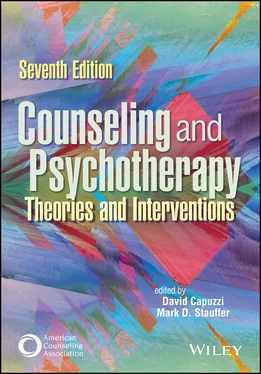Counseling and Psychotherapy
Здесь есть возможность читать онлайн «Counseling and Psychotherapy» — ознакомительный отрывок электронной книги совершенно бесплатно, а после прочтения отрывка купить полную версию. В некоторых случаях можно слушать аудио, скачать через торрент в формате fb2 и присутствует краткое содержание. Жанр: unrecognised, на английском языке. Описание произведения, (предисловие) а так же отзывы посетителей доступны на портале библиотеки ЛибКат.
- Название:Counseling and Psychotherapy
- Автор:
- Жанр:
- Год:неизвестен
- ISBN:нет данных
- Рейтинг книги:4 / 5. Голосов: 1
-
Избранное:Добавить в избранное
- Отзывы:
-
Ваша оценка:
- 80
- 1
- 2
- 3
- 4
- 5
Counseling and Psychotherapy: краткое содержание, описание и аннотация
Предлагаем к чтению аннотацию, описание, краткое содержание или предисловие (зависит от того, что написал сам автор книги «Counseling and Psychotherapy»). Если вы не нашли необходимую информацию о книге — напишите в комментариях, мы постараемся отыскать её.
Counseling and Psychotherapy — читать онлайн ознакомительный отрывок
Ниже представлен текст книги, разбитый по страницам. Система сохранения места последней прочитанной страницы, позволяет с удобством читать онлайн бесплатно книгу «Counseling and Psychotherapy», без необходимости каждый раз заново искать на чём Вы остановились. Поставьте закладку, и сможете в любой момент перейти на страницу, на которой закончили чтение.
Интервал:
Закладка:
The findings underline the significance and value of genuineness in communication with the client. Indeed, the results indicate that therapist genuineness can be a crucial process for healing and personality change and that self-disclosure can be [a] powerful and directional [intervention]. (pp. 222–223)
Implicit in this statement is the idea of the counselor’s ability to communicate and demonstrate this genuineness, not only for relationship enhancement but also to model this core condition so that clients can develop greater authenticity in their interactions with others.
Personal characteristics or behaviors that enhance a counselor’s or therapist’s ability to prove genuineness and congruence include, but are not limited to, the following:
The capacity for self-awareness and the ability to demonstrate this capacity through words and actions
The understanding of one’s own motivational patterns and the ability to use them productively in the helping relationship
The ability to present one’s thoughts, feelings, and actions in a consistent, unified, and honest manner
The capacity for self-confidence and the ability to communicate this capacity in a facilitative way in the helping relationship
Concreteness
Concreteness is the ability not only to see the incomplete picture that clients paint with their words but also to communicate to clients the figures, images, and structures that will complete the picture. In the process of exploring problems or issues, clients often present a somewhat distorted view of the actual situation. Concreteness enables the counselor or therapist to help clients identify the distortions in the situation and fit them together in such a way that clients are able to view the situation in a more realistic fashion. The concreteness helps clients clarify vague issues, focus on specific topics, reduce degrees of ambiguity, and channel their energies into more productive avenues of problem resolution.
Personal characteristics and behaviors that enhance a counselor’s or therapist’s ability to provide degrees of concreteness include, but are not limited to, the following:
The capacity for abstract thinking and the ability to read between the lines
The willingness to risk being incorrect as one attempts to fill in the empty spaces
The belief in one’s own competence in analyzing and sorting through the truths and partial truths in clients’ statements
The ability to be objective while working with clients in arriving at the reality of their situations
Warmth
Warmth is the ability to communicate and demonstrate genuine caring and concern for clients (Skovholt, 2005). Using this ability, counselors and therapists convey their acceptance of clients, their desire for clients’ well-being, and their sincere interest in finding workable solutions to the problems that clients present. The demeanor of the counselor or therapist is often the main avenue for communicating and demonstrating warmth, for it is often through nonverbal behaviors—a smile, a touch, tone of voice, a facial expression—that genuine caring and concern are communicated. The counselor’s or therapist’s capacity for transmitting concerns and caring to clients, either verbally or nonverbally, enables clients to experience, often for the first time, a truly accepting relationship.
Personal characteristics or behaviors that enhance a counselor’s or therapist’s ability to demonstrate warmth include, but are not limited to, the following:
The capacity for self-care, and the ability to demonstrate this capacity in both actions and words
The capacity for self-acceptance, basing this acceptance on one’s assets and liabilities
The desire for one’s own well-being, and the ability to demonstrate this desire through both words and actions
The desire to find, and successful personal experience in finding, workable solutions to one’s own problems, and the ability to communicate this desire through words and actions
Immediacy
Immediacy is the ability to deal with the here-and-now factors that operate within the helping relationship (Clemence et al., 2012). These factors are described as overt and covert interactions that take place between the client and the counselor or therapist. A client’s anger at a counselor or therapist, the latter’s frustration with a client, and the feelings of the client and counselor for each other are all examples of factors that need to be addressed as soon as they occur and develop (Mayotte-Blum et al., 2012). Addressing such issues in the safety of the helping relationship should help participants in two ways: Participants can (a) gain insight into personal behavioral patterns that may or may not be conducive to growth and (b) use this insight in relationships outside the helping relationship. As an example, a counselor might ask, “How is sharing with me right now, given our cultural difference and the mistrust you feel?” or “How is our work together going?” when a client has mentioned it is hard to share.
Dealing with these factors can be threatening, because it is often easier to deal with relationships in the abstract and avoid personal encounters. A counselor or therapist needs to be able to use this factor of immediacy to show clients the benefits that can be gained by dealing with issues as they arise. According to Egan (2013), immediacy not only clears the air but also is a valuable learning experience.
Personal characteristics or behaviors that enhance a counselor’s or therapist’s ability to use immediacy effectively include, but are not limited to, the following:
The capacity for perceptive accuracy in interpreting one’s own feelings for, thoughts about, and behaviors toward clients
The capacity for perceptive accuracy in interpreting clients’ feelings for, thoughts about, and behaviors toward the counselor or therapist
The capacity for and willingness to deal with one’s own issues related to clients on a personal as opposed to an abstract level
The willingness to confront both oneself and clients with what one observes to be happening in the helping relationship
HELPING RELATIONSHIPS: STRATEGIES
The previous section identified the core conditions that need to be present for effective development of the helping relationship. The difference between these core conditions and strategies is the subject of this section.
The core conditions relate to specific dynamics present in the personality and behavioral makeup of counselors or therapists that enable them to communicate with clients. The term strategies refers to skills gained through education and experience that define and direct what counselors or therapists do within the relationship to obtain specific results and to move the helping relationship from problem identification to problem resolution.
Various terms have been used to address this aspect of the helping relationship. Some authors prefer the term strategies (Combs & Avila, 1985; Cormier et al., 2013; Gilliland et al., 1989), others prefer the term skills (Halverson & Miars, 2005; Ivey et al., 2013), and still others prefer the term techniques (Belkin, 1980; Brown & Pate, 1983; Osipow et al., 1980). These terms, however, are interchangeable and, as noted earlier in this chapter, are often used in addition to techniques used in conjunction with specific theories.
We decided to use the term strategies , which denotes not only deliberative planning but also action processes that make the planning operational. We feel that both factors are necessary. For the purpose of the following discussion, we have grouped strategies into three categories: (a) strategies that build rapport and encourage client dialogue, (b) strategies that aid in data gathering, and (c) strategies that add depth and enhance the relationship.
Читать дальшеИнтервал:
Закладка:
Похожие книги на «Counseling and Psychotherapy»
Представляем Вашему вниманию похожие книги на «Counseling and Psychotherapy» списком для выбора. Мы отобрали схожую по названию и смыслу литературу в надежде предоставить читателям больше вариантов отыскать новые, интересные, ещё непрочитанные произведения.
Обсуждение, отзывы о книге «Counseling and Psychotherapy» и просто собственные мнения читателей. Оставьте ваши комментарии, напишите, что Вы думаете о произведении, его смысле или главных героях. Укажите что конкретно понравилось, а что нет, и почему Вы так считаете.












